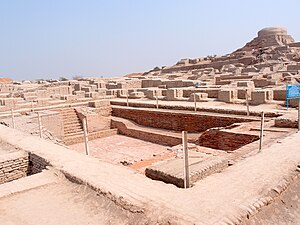Indus Valley Civilization
The Indus Valley Civilization, lasting from 2600 to 1900 BCE and with a population of five million people, has no strong evidence of having had warfare, inequality, or hierarchy.[1] It encompassed at least 800,000 square kilometers in land now known as "Pakistan, India and Afghanistan."[2] In a 2020 Journal of Archaeological Research article, archaeologist Adam S. Green posited, "The Indus civilization was egalitarian, but this is not because it lacked complexity; rather, it is because a ruling class is not a prerequisite for social complexity."[3]
Explanations for its eventual collapsed include attacks from outsiders, climate change, and earthquakes.[4]
Culture
There were five cities--Harappa, Rakhigarhi, Mohenjo-daro, Ganweriwala, and Dholavira--and many smaller cites.[5]
There is not strong evidence of temples or priests.[6]
Burial sites indicate that people were buried with roughly equal amounts of burial goods.[7]
There were apparently three recognized genders. In addition to women and men, there were hijras. Often intersex or assigned maleness at birth, they adopted feminine traits and tended to be either celibate or sexually involved with men.[8]
Decisions
There were no places, monuments to kings, or other indications of a state. One statue, theorized by earlier archeologists to be a "priest-king," is now widely considered to be a portrayal of a neighboring society.[9]
Economy
Farmers grew millets and rice in the summer and wheat and barley in the winter. Domesticated animals were used for meat, hide, bone, and traction.[10]
There were large collective works including drainage systems and the foundation for
Environment
- ↑ Peter Gelderloos, Worshiping Power: An Anarchist View of Early State Formation (Oakland: AK Press, 2016), 142.
- ↑ Andrew Robinson, "The real utopia: This ancient civilization thrived without war," New Scientist, 14 September 2016, https://www.newscientist.com/article/mg23130910-200-the-real-utopia-this-ancient-civilisation-thrived-without-war/.
- ↑ Adam S. Green, "Killing the Priest-King: Addressing Egalitarianism in the Indus Civilization," Journal of Archaeological Research, 2020.
- ↑ Robinson, "The real utopia."
- ↑ Green, "Killing the Priest-King."
- ↑ Green, "Killing the Priest-King." Gelderloos, Worshiping Power, 142.
- ↑ Green, "Killing the Priest-King."
- ↑ Sharri Clark, "Representing the Indus Body: Sex, Gender, Sexuality, and the Anthropomorphic Terracotta Figurines from Harappa," Asian Perspectives 42 (2003): 304–328. Retrieved from https://core.ac.uk/download/pdf/5105465.pdf.
- ↑ Green, "Killing the Priest-King."
- ↑ Green, "Killing the Priest-King.
